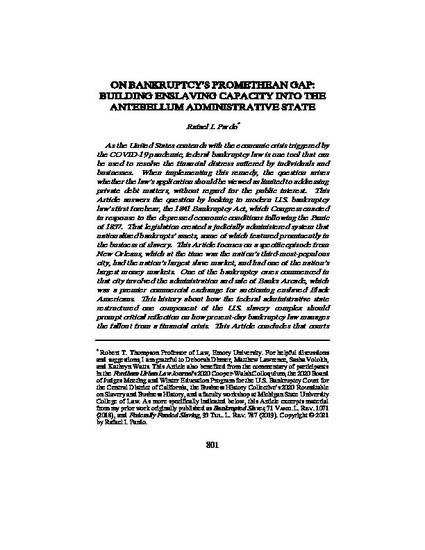
Article
On Bankruptcy's Promethean Gap: Building Enslaving Capacity into the Antebellum Administrative State
Fordham Urban Law Journal
(2021)
Abstract
As the United States contends with the economic crisis triggered by the COVID-19 pandemic, federal bankruptcy law is one tool that can be used to resolve the financial distress suffered by individuals and businesses. When implementing this remedy, the question arises whether the law’s application should be viewed as limited to addressing private debt matters, without regard for the public interest. This Article answers the question by looking to modern U.S. bankruptcy law’s first forebear, the 1841 Bankruptcy Act, which Congress enacted in response to the depressed economic conditions following the Panic of 1837. That legislation created a judicially administered system that nationalized bankrupts’ assets, some of which featured prominently in the business of slavery. This Article focuses on a specific episode from New Orleans, which at the time was the nation’s third-most-populous city, had the nation’s largest slave market, and had one of the nation’s largest money markets. One of the bankruptcy cases commenced in that city involved the administration and sale of Banks Arcade, which was a premier commercial exchange for auctioning enslaved Black Americans. This history about how the federal administrative state restructured one component of the U.S. slavery complex should prompt critical reflection on how present-day bankruptcy law manages the fallout from a financial crisis. This Article concludes that courts have the authority to permit the public to advocate for its interests in distressed assets redeployed through the federal bankruptcy system.
Keywords
- administrative law,
- bankruptcy,
- Bankruptcy Act of 1841,
- business history,
- legal history,
- race and the law,
- slavery
Disciplines
Publication Date
2021
Citation Information
Rafael I. Pardo. "On Bankruptcy's Promethean Gap: Building Enslaving Capacity into the Antebellum Administrative State" Fordham Urban Law Journal Vol. 48 Iss. 4 (2021) p. 801 - 882 Available at: http://works.bepress.com/rafael-pardo/1/
